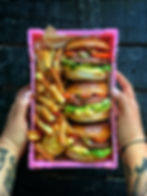Meating the Moment: How Restaurants Can Beat the Surging Cost of Beef
- eileen strauss
- Jul 31
- 4 min read
Updated: Aug 1

Key Takeaways
Beef prices are surging due to tariffs, feed costs, and supply chain issues.
Raise prices selectively, focusing on beef-heavy menu items and communicating value.
Smaller portions with premium presentation can preserve customer satisfaction and margins.
Plant-based and blended options are more relevant—and profitable—than ever.
Strong supplier communication can help lock in costs and uncover creative sourcing solutions.

How to Beat the Surging Cost of Beef
Beef prices are soaring in 2025, squeezing restaurant margins and making menu planning tougher than ever. With an important tariff deadline just hours away, plus record-high cattle feed prices, shrinking herds, and mounting labor and transport costs, wholesale beef is becoming one of the most expensive proteins to keep on your menu.
But smart operators know that with the right menu strategy and supplier relationships, it's possible tobeat the surging cost of beef without alienating guests or sacrificing profitability.

5 Smart Menu Moves to Offset Rising Beef Costs
1. Raise Prices with Intention
Price increases are inevitable—but they don’t have to scare off your guests. Start with targeted hikes on beef-heavy dishes where the value is already built-in, such as premium steaks or slow-braised short ribs.
Customers expect these to cost more, especially if you’re transparent about sourcing and quality. A subtle increase of $1–$3, paired with thoughtful menu design and server training, can help soften the impact while improving margins. Keep an eye on competitor pricing and be ready to adjust in stages.

2. Reduce Portions, Boost the Plate
Reducing portion sizes doesn’t mean reducing satisfaction. Consider scaling back 1–2 ounces of beef and redirecting focus to other high-impact elements: layered sauces, house-made condiments, or premium sides like charred broccolini, seasonal grains, or flavored butters.
Plating and presentation go a long way in making a trimmed dish still feel indulgent. This also aligns with modern diner trends—smaller portions, less waste, and more balance.

3. Where's the Beef? Going Plant-Forward
Leaning into plant-forward dining isn’t about going full vegan—it’s about creativity and cost control. Strategic swaps and blended dishes can reduce your beef dependency while opening the door to new diners and better margins.
Start with smart blends:Mixed-protein dishes offer the best of both worlds. A 70/30 mushroom-to-beef burger, for example, delivers umami-rich flavor with less meat and a lower plate cost. Market it as a “Chef’s Blend Burger” with toppings like caramelized onion jam and smoked gouda, and guests won’t miss the missing ounces.
When people think about a plant-based diet, they typically think about a diet that doesn't include meat, poultry, or fish. But plant-based diets vary in what foods they include and exclude:
Lacto-vegetarian diet. Excludes meat, fish, poultry, and eggs, as well as foods that contain them. Dairy products, such as milk, cheese, yogurt, and butter, however, are included.
Ovo-vegetarian diet. Excludes meat, poultry, seafood and dairy products, but allows eggs.
Lacto-ovo vegetarian diet. Excludes meat, fish and poultry, but allows dairy products and eggs.
Pescatarian diet. Excludes meat and poultry, dairy, and eggs, but allows fish.
Vegan diet. Excludes meat, poultry, fish, eggs, and dairy products — and foods that contain these products.
Flexitarian diet. More diners—especially Gen Z and Millennials—are exploring “less meat” eating. You don’t need to go fully vegan to meet them where they are. Just highlight bold, vegetable-forward dishes with craveable sauces, grains, and garnishes. Focus on texture, spice, and visual appeal. When it’s done right, the absence of meat isn’t even the headline.

Try these menu ideas to get inspired:
Short Rib and Shiitake Bolognese: Half short rib, half mushroom ragu over fresh pasta. Deep, rich flavor, less meat.
Jackfruit-Barbacoa Tacos: Pulled jackfruit tossed in chipotle adobo sauce, topped with beef-chili crema and pickled onions.
The Earth-n-Turf Burger: Grilled blended patty of lentil, mushroom, and ground chuck, stacked with arugula, truffle aioli, and smoked cheddar.
Sweet Potato with Braised Brisket Curry: A hearty plant-based base with small bites of brisket to add depth and savor.
Roasted Beet and Steak Grain Bowl: Ancient grains, pickled veg, seared steak slivers, and green goddess drizzle—high appeal with minimal meat.
Bonus tip: Offer these dishes as daily specials or on your lunch menu to test how they perform before adding them to your main lineup. With smart marketing and creative naming, they won’t just save you money—they could become bestsellers.

4. Stretch Beef in Composed Dishes
Instead of centering beef on the plate, make it a component. Add beef to rich ragùs, empanadas, pastas, curries, and stews where it enhances the dish without dominating it. Think braised brisket chili, short rib pappardelle, or beef pierogi with crispy onions. These types of meals deliver warmth, comfort, and flavor while keeping beef usage efficient. They also lend themselves well to batch cooking and prep-time savings.
5. Work the Supplier Relationship
This is the time to strengthen your ties with vendors. Stay in regular contact about price changes, upcoming shortages, and alternative cuts. Ask about pre-portioned options, beef blends, or underutilized cuts like tri-tip, chuck eye, or bavette, which can perform beautifully when prepared well.
If possible, explore locking in bulk pricing or signing onto a short-term contract to weather this period of volatility. Your supplier might also have insight into regional sources that reduce transportation costs.

Takeaway
Beef prices aren’t coming down anytime soon—but that doesn’t mean your profits have to go with them. By rethinking how beef appears on your menu, leaning into smart substitutions, and working closely with your suppliers, you can protect your bottom line while still delivering the quality and experience your guests expect.
A few small shifts today can help your restaurant stay competitive, creative, and cost-savvy through the beef surge and beyond.

By Eileen Strauss
